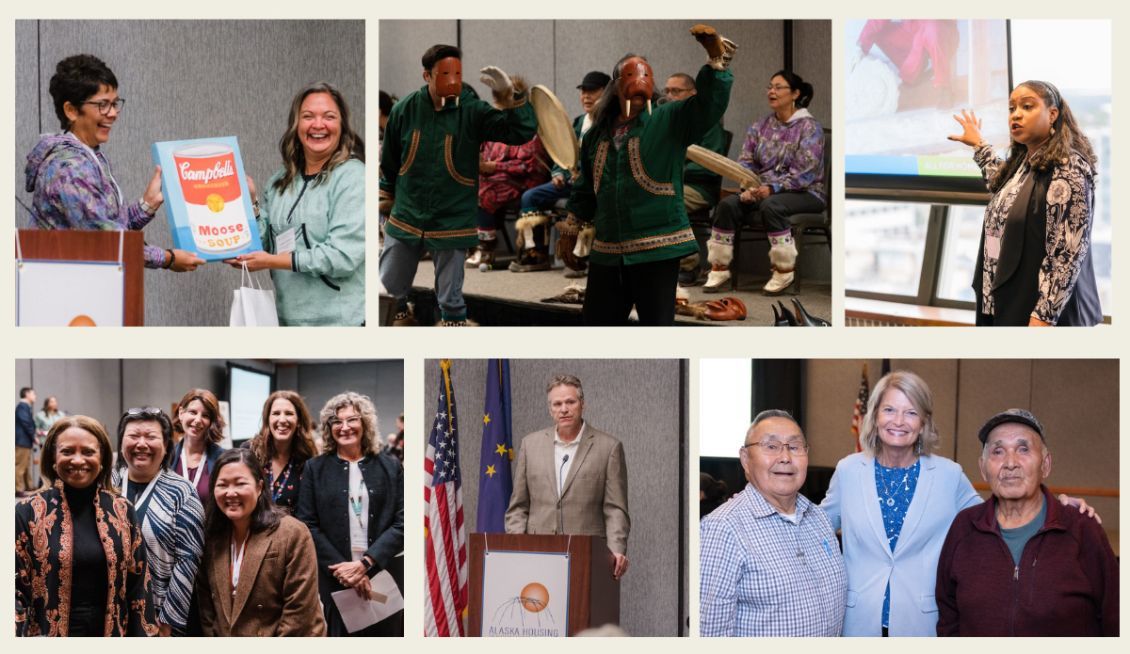The idea started as a dream. What if there were an opportunity for affordable housing providers and supporters to come together to share stories and elevate what was happening throughout Alaska?
That’s how Colleen Dushkin, Association of Alaska Housing Authorities (AAHA) executive director, described the vision behind the first Alaska Housing Innovations Summit.
And the opportunity proved inspiring.
The Power of Working Together
More than 220 participants from across the state gathered in Anchorage to talk about affordable housing needs and solutions during the two-day summit in early August hosted by AAHA and Enterprise.
“There are a lot of voices here,” said Jennie Rodgers, Enterprise VP, Mountain and Tribal Nations and Rural Communities Markets. “Our intent is to create partnerships to carry your work into the future.”
Partnership was a major theme of the summit coupled with the call for a culturally and climate responsible approach to building affordable homes tailored for Alaskan families and communities.
AAHA has long recognized the strength of collaboration, with a membership of 14 regional housing authorities (RHA) that provide housing development and services on behalf of 196 tribes. Alaska’s RHAs have built thousands of affordable homes since their inception in 1971 and are often the largest employer in rural areas and play an important role in local economies.
“We are demonstrating the power of working together – urban, rural and remote – rather than communities left on their own,” said Carol Gore, AAHA president and Cook Inlet Housing Authority president and CEO. “One finger cannot lift a pebble.”
Housing Challenges
Alaska’s housing stock is overcrowded, energy inefficient and more affordable homes are needed for all spectrums of households, including seniors, public safety officers, health care providers and educators, according to an AAHA report.
The report also cites these startling statistics from the Alaska Housing Finance Corporation’s 2018 Alaska Housing Assessment: To keep up with population changes, Alaska as a whole must increase its home construction by 11 percent over current rate of construction. Add in the need to alleviate overcrowding and keep up with population changes, the state will need to increase home construction by 90 percent. Additionally, the report points to the age and condition of existing housing that adversely impacts resident health and aging infrastructure that greatly impacts development.
Although Alaskans are faced with growing housing challenges, a significant barrier has been flat funding coupled with skyrocketing construction costs.
Communal Learning
Over the course of the two-day summit, more than 15 sessions were held to explore innovations that have been deployed in Alaska communities, new innovations that can potentially increase housing development, and established partnerships that have significantly impacted communities and Alaskan families.
Dushkin kicked off the summit with Working in Alaskan Communities to ground discussions on the unique needs and approaches especially for remote and native communities.
The topics ranged from USDA rural housing opportunities to testing conventional capital for homeownership to critical infrastructure to constructing for the changing climate.
Summit partner Freddie Mac conducted a listening session on how to improve financial products for Alaskan housing development. Taġiuġmiullu Nunamiullu Housing Authority demonstrated their ingenuity to construct for the changing climate. Financial experts educated on the range of support available for affordable rental development and homeownership. A critical infrastructure session explored water, sewer and air quality solutions to maintain public health in homes while a rent reporting workshop looked at improving resident credit and wealth building.
“Many participants thanked me for hosting a forum where it was specific to Alaska. Everything was relevant,” Dushkin said.
Speakers and Supporters
A wide range of elected officials, housing administrators and tribal representatives spoke throughout the summit about housing policy, funding programs and mission.
- Alaska Governor Michael Dunleavy
- U.S. Sen. Lisa Murkowski
- U.S. Sen. Dan Sullivan (via video)
- HUD Deputy Secretary Adrianne Todman
- Carol Gore, AAHA president and Cook Inlet Housing Authority president/CEO
- Sophie Minch, CIRI president/CEO
- D.J. Vanas, Ottawa Tribe member and author
The summit was made possible with a substantial investment from Freddie Mac. Sponsorships were made by: CIRI, Weidner Apartment Homes, Wells Fargo, Alaska Mental Health Trust Authority, National Equity Fund, NeighborWorks America, Aleut Corporation, AMERIND, Cold Climate Housing Research Center, Enterprise Community Partners, KeyBank, Kodiak Island Housing Authority and Sealaska.
Moving Forward
Dushkin sums up the event’s success and how the two-day conference will help increase quality, affordable homes.
"The attendees had a unique opportunity to hear from and engage with many housing experts and state and federal partners,” she said. “I hope our partners came away with a deeper understanding of Alaska, our dynamic delivery system and housing community, and an energy to invest in the phenomenal work happening in our communities.
“I hope our community members were able to make connections and pick up useful tools to advance the development of safe, sanitary and affordable housing in their communities.”


